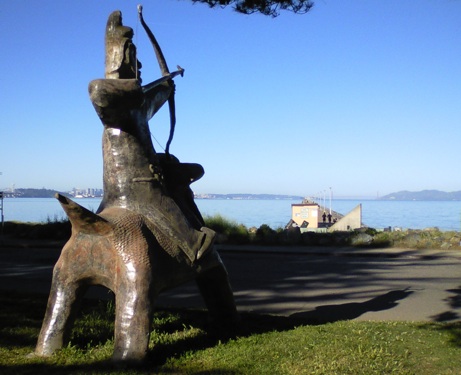
‘The Guardian’ by Frederic Fierstein, 1985, at the foot of the Berkeley Pier.
I’ve always admired the huge concrete sculpture depicting an archer/warrior seated on a mysterious creature at the foot of the Berkeley Pier. A genuine Berkeley landmark, ‘The Guardian’, made by Frederic Fierstein and a small group of collaborators in the mid-eighties, functions as much as a way-finder as a totemic talisman. I’ve been especially drawn to it lately as I prepare to begin contruction of Makkeweks, our giant seamonster sculpture pending final approval for the City of Oakland. Makkeweks will be cast in bronze from a wooden original, so the materials and technology are much diffrent, but I want our sculpture to have a similar presence as an icon in the cityscape.
Researching ‘The Guardian’, I was surprised to discover that the sculpture was made without City approval and was daringly just dropped off by the artist, or ‘donated’, as he would likely prefer. This early example of what came to be known as ‘plop art’ ignited a controversy in Berkeley as to whether the sculpture should remain. A vocal representation of Berkeley residents who loved the radical gesture by Fierstein eventually won out, and the City voted to adopt the piece as a permanent installation.
To read more about the fascinating story behind the ‘The Guardian’ and a recent interview with the artist, click here.







